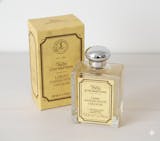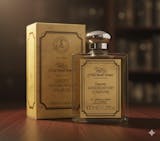Straight Razor Basics: How the Modern Straight Razor is Produced

You probably think, given the widespread demand for straight razors, that these are manufactured with assembly-like precision by an automated machine capable of finishing thousands by the hour. But nope, that’s not how it’s done.
While the manufacturing process still uses machines, it also needs a level of craftsmanship to produce a razor that has a sharp edge and feels luxurious. That’s what makes an excellent straight razor.
So how is a straight razor produced?
It begins with a blade blank.
Forging the Blade
According to the fine folks at A.P. Donovan, blank blades are cut from steel strips which are about the size of a standard straight razor blade. These blank blades are then heated in a furnace to make the steel malleable. The red-hot blanks are then formed into a blade shape by using a very heavy die.
The blades are then left to cool. During this stage, there will be some excess metal on the blade blank. The next step would be to trim it precisely so that the finished blade blank profile will be clean and smooth.
Hardening the Blade
This next step hardens the steel so that the blade will have a sharp edge. First, the blade bank is covered with graphite powder and dipped into a bath of molten lead for four minutes. The graphite prevents the lead from sticking to the blank.
Then it is dipped into a bath with a special, cold oil. The sudden change in temperature often causes the steel to be slightly warped. To correct this, the blades are realigned by hand using a hammer.
Shaping the Blade
Now that the hard and sweaty work of forging and hardening the blade is over, this next stage is all about the fine detailing of the blade. Master craftsmen take over the process, using their skills to begin shaping the blade.
First, the tip and the back of the blade are shaped. There are various blade tips with different purposes but in Naked Armor, our straight razors have the semi-round Dutch point because it’s more forgiving to sudden changes in angle or direction. This decreases the chances of accidental cuts or nicks.
Afterwards, the next parts to be shaped are the tang and the tail. The razor can be opened later using the narrow, tapering tail. In addition, it acts as a support for one or more fingers when shaving with the razor. The tang serves as a link between the blade and the tail. It also provides support for the fingers during shaving.
Going Through the Grind
The next phase is what makes a razor blade different from your regular knife blade. While kitchen knives have a flat surface, razor blades are distinguished by their inward curved shape. This gives the razor blade the highest degree of elasticity and suppleness which is important in order to get an awesomely close shave.
The Naked Armor blade is unique in that it is designed in a combination of a full hollow grind and a half hollow grind. This makes it more versatile and can easily be used for different types and textures of hair. It’s also good for shaving beginners and professionals alike.
After the grinding process, the ridge that forms between the main part of the blade and the cutting edge must be filed down.
The straight razor blade is then sharpened slowly and gradually. The so-called thinning process involves the steel of the cutting edge being gradually ground down, resulting in a pronounced ridge on the blade. The blade grinder continually checks the sharpness of the blades by running his thumbs across the surface of the blade. Experienced grinders can recognize from the sound that is produced whether the desired sharpness has been achieved.
A straight razor can last a long time and can even become an heirloom piece whose value will increase as the years go on.
— D'Rock, Naked Armor Founder
Finishing the Blade
After the thinning process, the blade is checked manually for imperfections. Any flaws in the metal structure in the tang or tail are removed by a grinding or polishing machine. It then receives its finish. A grinding paste is applied on the blade. The blade is then polished on the sisal disc, buffed to a mirror finish. Sometimes, craftsmen have their own tricks of the trade to make the razor even more polished. For example, by adding chalk to the leather polishing disc, the razor’s spine and cutting edge will become polished to a blue or clear finish.
Stropping the Straight Razor
Now that the straight razor is fully assembled, it has to be stropped. Stropping realigns the blade’s edges so that the straight razor can be used immediately right out of the box.
Cheap straight razors will be dull from the get-go or go dull after a few shaves. With a Naked Armor straight razor, that won’t happen because it’s stropped with a leather belt during the assembly process. That being said, we always advise to strop the blade after using it or when you start. It's a good technique to maintain the blade’s sharpness.
Attaching the Scales
Now that the blade is polished, sharp, and ready, the next part is attaching the scales. The type of scales matters in straight razor manufacture. If the material isn’t well-crafted and durable, it will be difficult to maintain a firm and steady grip on the razor. Unless you want to go Sweeny Todd on your throat, you would want a durable scale.
These days, plastic and resin are commonly used as scales for straight razors. For the more discerning man, there are also razors which come equipped with quality wooden scales. Similarly, there are also metal scale straight razors, but there is not much demand for those because it is difficult to achieve the proper tension needed for the pivot pin (the rivet that holds the scales together over the blade) to work properly.
Here at Naked Armor, our scales are made of the finest quality to be at par with our blades. They’re made from algum, a high-value species of sandalwood that was thought to be one of the mythical timbers used in the building of King Solomon’s temple. Skilled artisans shape the wood and attach it to the blade precisely, resulting in a straight razor that is luxurious and elegant, with a sense of history.
Quality World Class Straight Razors
Once the scales are attached, the straight razors undergo a final quality inspection before being packed for inventory. The level of care and attention lavished on each straight razor is part of the reason why they are more durable than your ordinary plastic cartridge razors.
A straight razor can last a long time and can even become an heirloom piece whose value will increase as the years go on. That’s why they can be slightly expensive.
Still, the initial cost does not outweigh the benefits in using a high-quality straight razor. Not only do they provide the closest shave but they are also more eco-friendly than a plastic razor.
Want to see more high-end straight razors and shaving products? Check out this site.
Other Naked Armor Reads
Does Picking the Right Handle for a Straight Razor Matter?
What Size Straight Razor Should I Use?
Shave Like A Man



























Leave a comment